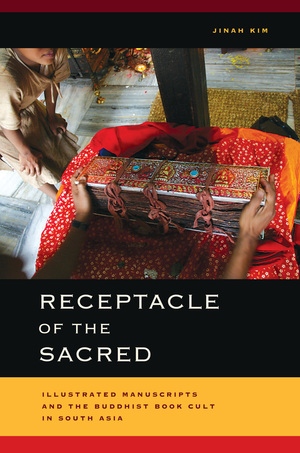
图书信息:
Jinah Kim. Receptacle of the sacred: Illustrated Manuscripts and the Buddhist Book Cult in South Asia, University of California Press,2013.
图书简介:
In considering medieval illustrated Buddhist manuscripts as sacred objects of cultic innovation, "Receptacle of the Sacred" explores how and why the South Asian Buddhist book-cult has survived for almost two millennia to the present. A book "manuscript" should be understood as a form of sacred space: a temple in microcosm, not only imbued with divine presence but also layered with the memories of many generations of users. Jinah Kim argues that illustrating a manuscript with Buddhist imagery not only empowered it as a three-dimensional sacred object, but also made it a suitable tool for the spiritual transformation of medieval Indian practitioners. Through a detailed historical analysis of Sanskrit colophons on patronage, production, and use of illustrated manuscripts, she suggests that while Buddhism's disappearance in eastern India was a slow and gradual process, the Buddhist book-cult played an important role in sustaining its identity. In addition, by examining the physical traces left by later Nepalese users and the contemporary ritual use of the book in Nepal, Kim shows how human agency was critical in perpetuating and intensifying the potency of a manuscript as a sacred object throughout time.
ISBN
9780520273863 (cloth : alk. paper)
0520273869 (cloth : alk. paper)
目 录
Acknowledgement
List of Figures
List of Diagrams
Introduction. Text, Image and the book
Chapter 1. Buddhist books and their cultic use
Chapter 2. Innovations of the Medieval Buddhist Book-cult
Chapter 3. Representing the Perfect Wisdom, Embodying the Holy Sties
Chapter 4. The Visual World of Buddhist Book Illustrations
Chapter 5. Esoteric Buddhism and the Illustrated Manuscripts
Chapter 6. Social History of the Buddhist book-cult
Chapter 7. Epilogue: Invoking a goddess in a book
Bibliography
Index
图书推介:
In considering medieval illustrated Buddhist manuscripts as sacred objects of cultic innovation, "Receptacle of the Sacred" explores how and why the South Asian Buddhist book-cult has survived for almost two millennia to the present. A book "manuscript" should be understood as a form of sacred space: a temple in microcosm, not only imbued with divine presence but also layered with the memories of many generations of users. Jinah Kim argues that illustrating a manuscript with Buddhist imagery not only empowered it as a three-dimensional sacred object, but also made it a suitable tool for the spiritual transformation of medieval Indian practitioners. Through a detailed historical analysis of Sanskrit colophons on patronage, production, and use of illustrated manuscripts, she suggests that while Buddhism's disappearance in eastern India was a slow and gradual process, the Buddhist book-cult played an important role in sustaining its identity. In addition, by examining the physical traces left by later Nepalese users and the contemporary ritual use of the book in Nepal, Kim shows how human agency was critical in perpetuating and intensifying the potency of a manuscript as a sacred object throughout time.
(source: Nielsen Book Data)